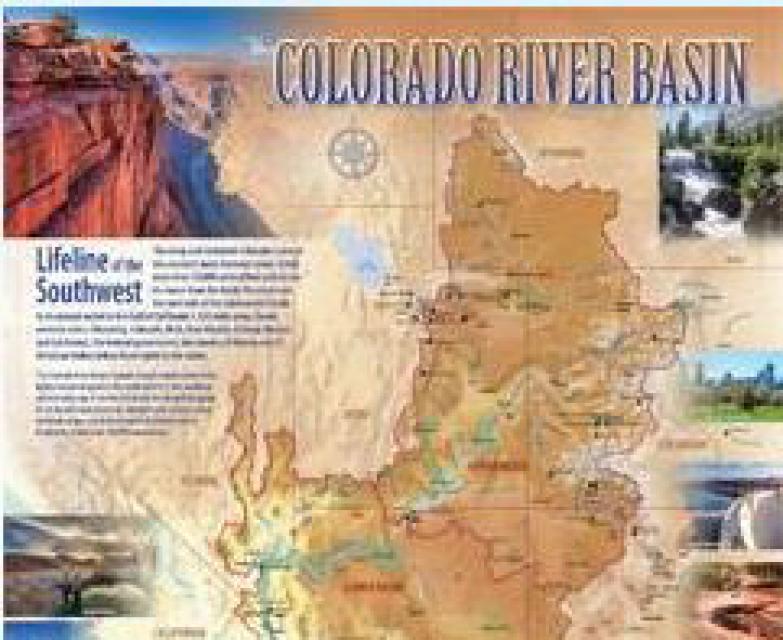WESTERN WATER-Changes Loom for Innovative Lower Colorado River Endangered Species Program Amid Drought, New River Rules
Read our Western Water Article, Water Word of the Day and Five Don't-Miss Water Reads from Across the West
Dear Western Water readers:
 Before the construction of Hoover
Dam on the lower Colorado River, the stretch downriver served as
a biological oasis in the middle of the unrelenting Mojave and
Sonoran deserts. The marshes and backwaters along the river’s
edge provided sheltered areas for fish to spawn and rear their
young, and mesquite and cottonwood-willow forests provided
important habitat for numerous species of birds and other
animals.
Before the construction of Hoover
Dam on the lower Colorado River, the stretch downriver served as
a biological oasis in the middle of the unrelenting Mojave and
Sonoran deserts. The marshes and backwaters along the river’s
edge provided sheltered areas for fish to spawn and rear their
young, and mesquite and cottonwood-willow forests provided
important habitat for numerous species of birds and other
animals.
When Lake Mead began filling behind Hoover Dam in 1935, the water it held transformed deserts into some of the nation’s most productive farmland and created some of the West’s most populous cities such as Los Angeles, Phoenix and Las Vegas. But it drastically reduced the amount of water flowing downstream, radically altering the habitat there and setting up a collision between human and environmental needs as more and more species were deemed threatened or endangered.
For municipal and agricultural water managers who depended on the Colorado, the growing list of endangered species was a wakeup call. It spurred a decade-long effort to craft a long-term multi-party agreement that allowed water agencies to continue delivering water to their users while staying ahead of the mounting endangered species issues.
Our latest Western Water story explores how that effort, intended to last 50 years, has largely proven successful. But as the Lower Colorado River Multi-Species Conservation Program crosses the 20-year mark, new questions are arising about how to keep it strong in the face of grinding drought, contentious negotiations over the river’s future and new uncertainties about the federal government’s role in its continued implementation.
Read more about the challenges ahead for the Lower Colorado River Multi-Species Conservation Program in Western Water.
Water Around the West
Five don’t-miss articles from California and across the West:
Salmon return to the Klamath’s Oregon waters, but the river’s headwaters are still blocked: Cassandra Profita with Oregon Public Broadcasting explores the efforts to bring salmon back to the Klamath River, where four dams blocking fish passage were recently removed, and the challenges that still lie ahead.
How to get rid of toxic ‘forever chemical’ pollution: XiaoZhi Lim, writing in the science publication Nature, explores the challenges behind ridding drinking water of PFAS, the so-called “forever chemicals” that can endanger human health, and some of the emerging technologies now being developed to address the problem.
Dwindling water supply, legal questions push Colorado River into ‘wildly uncharted territory’: Heather Sackett, writing for Aspen Journalism, explores the simmering conflicts among Colorado River Basin states over a potential legal “tripwire” in the century-old Colorado River Compact, and how it could push the states into court even as they try to craft new rules for the river’s management.
Logging doesn’t prevent wildfires, but Trump is trying it anyway: Ayurella Horn-Muller, writing for the online magazine Grist, examines the federal government’s push to do more logging in national forests and how the effort could worsen the threat of fire in the nation’s watershed forests.
Why water fluoridation, long considered a public health success story, is under scrutiny: Associated Press writers Mike Stobbe and Kasturi Pananjady explain the science behind fluoridation of drinking water, the potential health risks from exposure to too much fluoride and why the federal government is reconsidering its water fluoride recommendations.
Western Water Word of the Day
 Twenty years ago this month, the
federal government and non-federal participants signed an
agreement that officially launched the
Lower Colorado River Multi-Species Conservation
Program to recover 27 species in the
lower Colorado River, including seven the federal government
has deemed endangered or threatened with extinction. Under
it, the Bureau of Reclamation, irrigation districts and municipal
water agencies committed to a 50-year, $626 million
inflation-adjusted program, splitting the cost evenly between the
federal government and state parties, to create at least 8,132
acres of new habitat and restore habitat that has become
degraded. Learn more about theLower Colorado River
Multi-Species Conservation Program in Aquapedia, our online water
encyclopedia.
Twenty years ago this month, the
federal government and non-federal participants signed an
agreement that officially launched the
Lower Colorado River Multi-Species Conservation
Program to recover 27 species in the
lower Colorado River, including seven the federal government
has deemed endangered or threatened with extinction. Under
it, the Bureau of Reclamation, irrigation districts and municipal
water agencies committed to a 50-year, $626 million
inflation-adjusted program, splitting the cost evenly between the
federal government and state parties, to create at least 8,132
acres of new habitat and restore habitat that has become
degraded. Learn more about theLower Colorado River
Multi-Species Conservation Program in Aquapedia, our online water
encyclopedia.
At the Foundation
 The Water Education Foundation is
hosting an open house and reception on May 1 as part of the
Big Day of Giving campaign. Visit our office any
time between 3:30 and 6:30 p.m. to
meet our
team and learn more about what we do to educate
and inspire understanding of the most precious natural
resource in California and across the West — water! Enjoy
happy hour refreshments and appetizers while catching up on our
latest tours, conferences, maps, water news and
training programs for teachers and up-and-coming water
professionals. Please join us, but RSVP by April 29!
More information
and registration details can be found here.
The Water Education Foundation is
hosting an open house and reception on May 1 as part of the
Big Day of Giving campaign. Visit our office any
time between 3:30 and 6:30 p.m. to
meet our
team and learn more about what we do to educate
and inspire understanding of the most precious natural
resource in California and across the West — water! Enjoy
happy hour refreshments and appetizers while catching up on our
latest tours, conferences, maps, water news and
training programs for teachers and up-and-coming water
professionals. Please join us, but RSVP by April 29!
More information
and registration details can be found here.
Western Water Resource
 Our Colorado River
Basin Map depicts the seven Western states that
share the Colorado River with Mexico. The Colorado River supplies
water to nearly 40 million people in Arizona, California,
Colorado, Nevada, New Mexico, Utah, Wyoming and Mexico. The
map features rivers, dams, water projects, major cities, Indian
reservations, irrigated areas, basin boundaries, and national
parks and monuments. Order your copy
here.
Our Colorado River
Basin Map depicts the seven Western states that
share the Colorado River with Mexico. The Colorado River supplies
water to nearly 40 million people in Arizona, California,
Colorado, Nevada, New Mexico, Utah, Wyoming and Mexico. The
map features rivers, dams, water projects, major cities, Indian
reservations, irrigated areas, basin boundaries, and national
parks and monuments. Order your copy
here.








